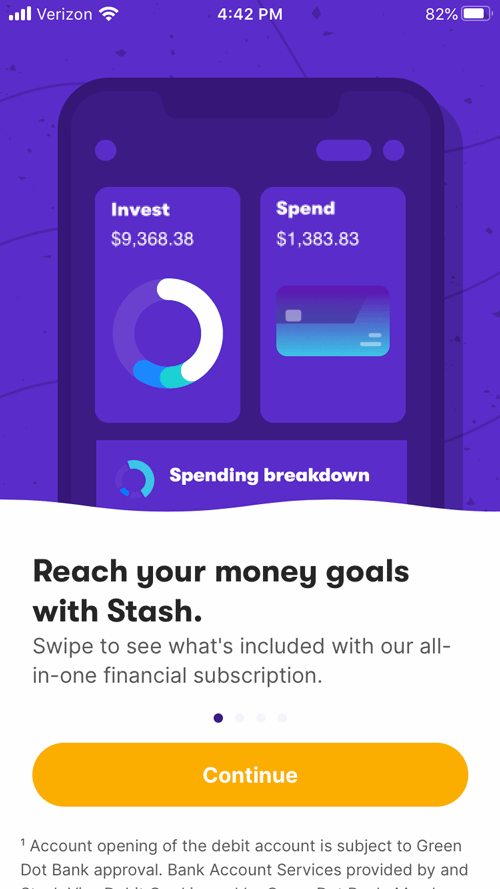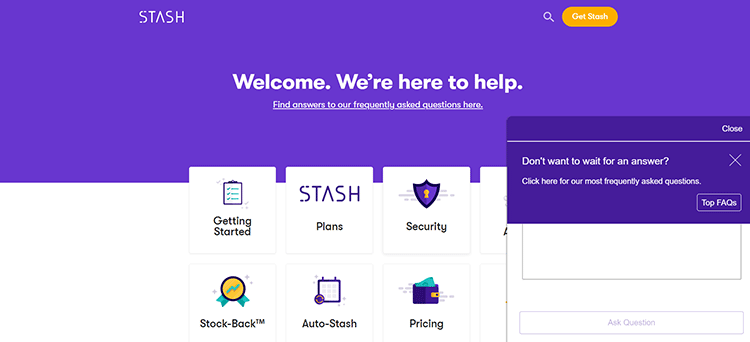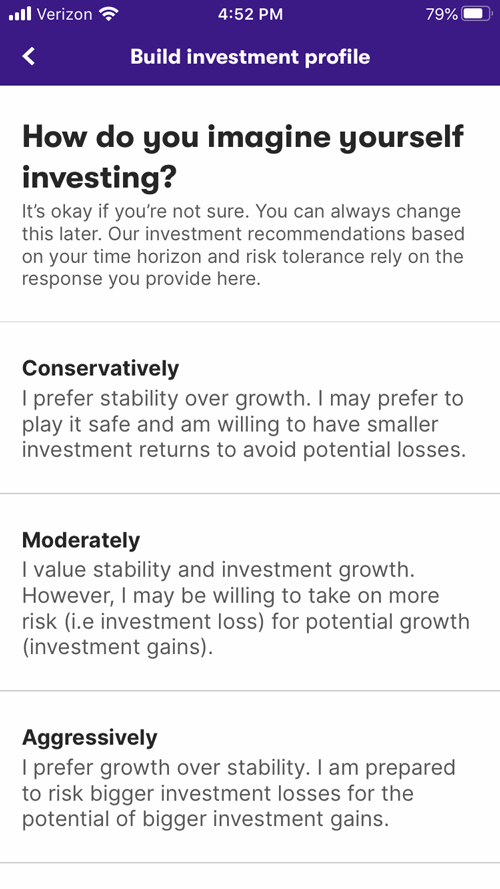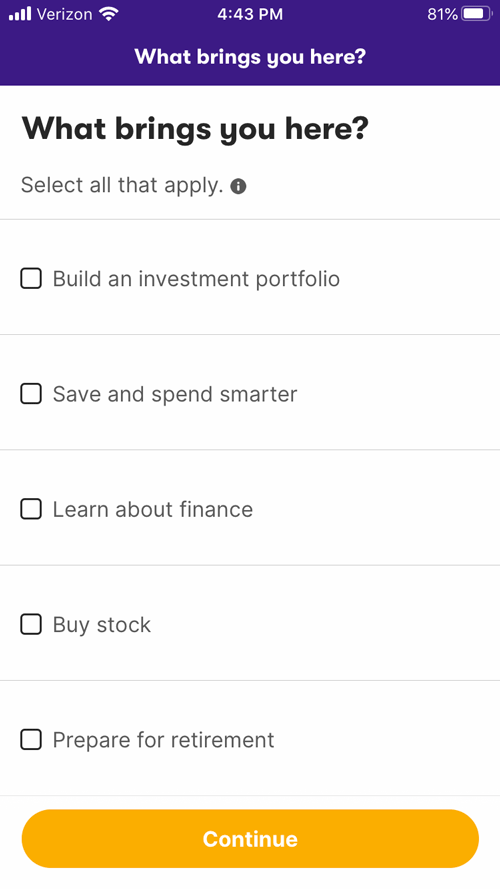Investing is rapidly becoming a more accessible and user-friendly way to earn money and build wealth. With popular 0$ investing apps like Robinhood and user-friendly robo-advisors like Acorns, it’s easier than ever to become an investor. That brings us to Stash, the app that aims to be the best place for all your financial needs. But what is Stash? How does it work? Is Stash safe? And, most importantly, should you use it? Our Stash review will answer all of these questions and more.
Stash Review Score
Name: Stash
Description: is an investing app that makes it easy for first-time investors to pick stocks and ETFs. With a few different account options and a rewards program, Stash helps you make the most efficient use of your investments.
Overall
-
Pricing
-
User Experience
-
Ease Of Use
-
Customer Service
Summary
Stash is an investing app that makes it easy for first-time investors to pick stocks and ETFs. With a few different account options and a rewards program, Stash helps you make the most efficient use of your investments.
Pros
- $0 account minimums
- $0.01 investment minimum with fractional shares
- Risk levels for all available investments
- Stash portfolio builder
- Stock-Back rewards program
- Round-up investing automation
Cons
- High annual fees compared to other competitors
- No portfolio management
What Is Stash?
Stash is an investing app that makes it easy for first-time investors to pick stocks and ETFs. With a few different account options and a rewards program, Stash helps you make the most efficient use of your investments.
Stash’s overall goal is to give users a one-stop-shop for everything they need to invest. From $0 account minimums to fractional shares, Stash makes investing more accessible for the average American.

How Does Stash Work?
By paying a monthly fee between $1 per month and $9 a month, you gain access to different tiers of service. Here, we see Stash functioning very similarly to an app like Acorns.
Depending on your subscription tier, you’ll get access to a variety of different features.
For the $1 a month tier (Stash’s “Beginner” level), you get:
- Personal investment accounts
- Plastic debit card and linked online bank account
- Rewards via Stock-Back program
For the $3 a month tier (Stash’s “Growth” level), you get:
- Personal investment accounts
- Plastic debit card and linked online bank account
- Rewards via Stock-Back program
- Traditional and Roth IRA accounts
For the $9 a month tier (Stash’s “Stash+” level), you get:
- Personal investment accounts
- Metal (not plastic) debit card and linked account
- 2x Rewards via Stock-Back program
- Traditional and Roth IRA accounts
- Two custodial accounts for kids
- Monthly report on current market trends
Once you’ve chosen a subscription tier, you’re ready to start investing. Thankfully, Stash makes it easy for you to pick investments.
What Makes Stash Unique?
Stash’s most unique feature is the amount of customization and personalization you have when creating your portfolio. Using their in-app questionnaire, Stash will assign you a level of risk tolerance. Then, you can decide on your personal preferences (socially responsible investing, specific sectors, etc.).
One of the great things about investing with Stash is that your investment options all show a risk level when you click them. This makes choosing your own investments easy since Stash gives you the critical information you need to make good decisions.
That said, we always recommend investing with ETFs rather than picking individual stocks.
Each investment on Stash also has a breakdown of the company(s) involved, whether the security is a stock or an ETF, the current price, and its expense ratio. This is very important because low expense ratios can make a huge difference to the amount of wealth you can build up.
In addition to the large amounts of information, Stash has a lot of useful tools to help you create your portfolio. If you’re looking for a gentle introduction to making a diversified portfolio, Stash can be a great first step in that journey.
Pros & Cons Of Stash
Stash Pros
- $0 account minimums
- $0.01 investment minimum with fractional shares
- Risk levels for all available investments
- Stash portfolio builder
- Stock-Back rewards program
- Round-up investing automation
Stash Cons
- High annual fees compared to other competitors
- No portfolio management
How Much Does Stash Cost?
Stash’s subscription costs are $1, $3, or $9 per month. This may not seem like much, but over the course of a year, that’ ‘s $12, $36, and $108, respectively.
Combine these subscription fees with the slightly higher expense ratios for Stash’s ETFs, and you get costs that are higher than its competitors.
Is Stash Safe?
The short answer, yes. Stash uses the same type of electronic encryption most banks use. Plus, Stash has employees at all its physical locations, meaning any buildings that store your data are well-guarded.
While a security breach is always possible with any company, Stash encrypts your personal data and has two-factor authentication. This means using Stash to invest involves minimal risk.
Here’s a direct quote from Stash on the safety of their platform:
“Protecting you is one of our top priorities. That’s why we employ advanced physical, electronic, and procedural safeguards—including 256-bit encryption and Secure Sockets Layer (SSL)—to keep your money, identity, and personal information safe. All Stash software, hardware, and IT infrastructure are kept secure with multiple levels of defense.”
Stash.com
In terms of your investments, Stash offers SIPC protection. SIPC protection covers up to $500,000 in securities or $250,000 in cash, meaning your investments are safe against Stash going bankrupt.
How Does Stash Make Money?
Stash makes its money through the monthly subscription fees. This is where the vast majority of their revenue comes from. However, there are also a few random fees they charge for specific actions.
The expenses are mostly related to receiving paper copies of your account statements. If you’re curious, here’s a whole list of Stash’s other fees.
How Is Stash’s Customer Service?

Stash has both a live chat feature and an email service. Both of these services were useful sources of information, but I found the FAQ section to be more than enough to answer most of my questions.
But, it is unfortunate that Stash doesn’t have any customer service via phone. While live chats are always useful, talking to a live person over the phone is often a much quicker way to resolve your issues.
What I Wish Was Different About Stash
Honestly, I’m not a huge fan of investing platforms that use flat monthly fees. Yes, these can be cheaper for accounts with thousands of dollars. But for the average person, flat fees often end up costing a lot more than percentage-based ones.
Let’s use Betterment as a point of comparison. Betterment charges 0.25% annually, while Stash costs $12, $36, or $108 each year, depending on the tier.
If your account has $1,000, Stash will end up costing 1.2%, 3.6%, or 10.8% of the total account value. Compare that to Betterment’s 0.25%. Put into dollars, this is the difference between paying $2.50 a year vs. $12 – $108. And this difference only worsens as you use smaller amounts.
That said, if your account has at least $5,000, $12 a year in charges works out to 0.24% of the total account value. If your account has at least $15,000, $60 a year for Stash’s Growth plan becomes 0.24%. And, if you have Stash+, you’d need at least $45,000 for Stash to be cheaper than Betterment.
So, if you’re using thousands of dollars, it may be cheaper to use Stash (assuming you don’t care about some of the other services offered by different brokerages). But as you’re just starting out, it’s cheaper to use another service like Betterment.
How Does Stash Fare Against Competitors?
We’ve already talked about how Stash’s fee structure fares against its competitors. But, what about their features?
When it comes to educational resources, Stash’s portfolio-building tool is a great way to learn by example. With the Portfolio Builder, you can just give Stash your risk tolerance and investment goals and get back a complete list of which investments you should choose in order to have a diversified portfolio. This is incredibly useful because it lets you play around with different risk levels and goals to see how each plays into your portfolio.
Also, Stash’s account and investing minimums are hard to beat. By having $0.01 and $0 minimums, Stash helps make getting started easy. This removes many of the barriers to entry for would-be investors, making Stash a great place for new investors to get started.
As the final point of comparison, let’s talk about ease of use. This is another area where Stash is one of the best, stacking up well against even the best robo-advisors. It takes only a few minutes to get started on Stash.
How To Get Started On Stash
When you first open up the Stash app, you’ll have to fill out some basic information. This includes inputting your email address, creating a password, and verifying some biographical information like your name, residential address, and social security number.
Next, you’ll give information about your annual income, marital status, dependents (children less than 18 years old), whether you own or rent your home, and a few other pieces of information that Stash will use to inform your investing recommendations.
This is all standard information that almost any online broker would collect.

Then, you’ll fill out Stash’s risk assessment and choose your goals. Once you’ve done this, Stash will show you several investment options that are geared towards someone with your goals and risk tolerance.
You can feel free to investigate these options more before choosing some, but you aren’t locked in until you’ve funded your account. After picking which stocks and ETFs you want to invest in, you’re ready to link a bank account and start investing!
This whole process only took 3-4 minutes from start to finish.
Should You Use Stash?
If you’re looking for an easy to use app that helps you learn the basics of how to invest, Stash could be exactly what you need. Thanks to their portfolio builder and available information about an investment’s key factors, you’ll be able to build a diversified portfolio without needing to know all of the ins and outs of investing.
However, more advanced investors will quickly find themselves outgrowing Stash in favor of more feature-rich alternatives like Webull.
Ultimately, Stash can be a great resource for the budding investor. If you want a quick and easy way to start investing while still getting some guidance along the way, you should check out Stash.

FAQs
Many people are afraid of handing over personal information to an app or website. But with their long track (they’ve been around since 2015) and their high-level security measures, you can rest assured Stash is legitimate.
Stash works like any other investing app, which means while yes, you can make money off Stash, it isn’t necessarily a guarantee. The stock market can have a lot of short term ups and downs, so it’s important to understand the risks.

Lucas is a personal finance expert, an undergraduate student at Harvard University and the founder of the Personal Finance and Consulting Group at Harvard College (an officially recognized student organization). He has spent much of his life working to increase financial literacy in his surrounding communities through independent financial research and curricula design, and he is currently studying economics with a secondary in music.